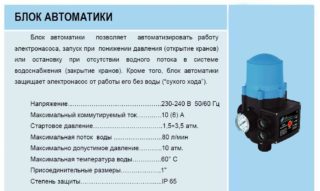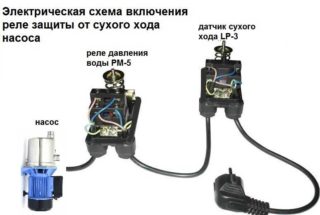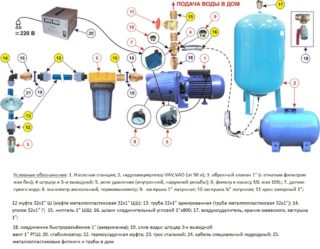So that the pumping equipment does not fail ahead of time, you need to install at least a minimum set of automation. It includes a dry running sensor, which will turn off the device when the liquid level in the well drops; a sensor that regulates the supply of electricity and turns off the device in case of phase imbalance; as well as a pressure switch. With each new model, the pumps are becoming more complex, so you have to install smarter automation.
Appointment of automation for pumps of water supply systems
- for systems with a hydraulic accumulator;
- for operation without a diaphragm tank, when the pump turns on when the tap is opened;
- universal devices.
The pumps are not designed to operate outside the liquid, and in the summer, water often goes down or, when the ground moves, completely disappears from the well. This may not be noticed, but 2-3 minutes of dry running is enough for the equipment to completely break down. Against such cases, various sensors have been developed that turn off devices and do not turn on until the problem is solved. Sometimes it is enough to simply lower the suction hose or immersion unit below the water table and the equipment starts up. In other cases, you will need to dig a well elsewhere.
If the pump runs for some time without water, two sensors can react at once - from dry running and from overheating. Submersible equipment is cooled only by being constantly in a cold liquid. If it is not there, it is better to turn off the pump.
Operating principle
Depending on the complexity of the equipment, consumers can choose one of three options for automatic functions:
- 1st generation automation - the minimum set of sensors that protect the pump from breakdowns. It includes a protection that is triggered in the absence of liquid in the well, a storage tank as part of the system, a pressure switch configured to turn on and off when two thresholds are reached - operating and minimum.
- 2nd generation automation. In this case, the sensors are connected to the electronic control unit. Installed along the entire highway, they can be used to monitor the state of the entire system. In addition to the standard set, it includes a sensor that detects a break in the water main. Such systems are more expensive, but can do without a membrane tank.
- Automation of the 3rd generation is a complex system that requires a specialist to connect and configure. It includes a full range of protective functions. Here, the presence of a hydraulic accumulator is not so important. The new system is able to regulate the power of the engine - with conventional automatic the engine normally runs at full speed and consumes a lot of electricity.With a low flow rate of liquid, this is not necessary, therefore, the control unit monitors with what intensity the water is consumed, and accordingly adjusts the operation of the engine. This prevents premature wear and tear and also reduces electricity bills.
For different types of pumping equipment, their own automation is selected, since its types may not be suitable for a submersible or surface water intake device.
Criterias of choice
Automation for a submersible pump with a hydraulic accumulator and a pressure switch must match the capabilities of the equipment. For example, a set of 3rd generation sensors controls the process frequency. If the pump does not support such a function, there is no point in overpaying for an expensive system - it will not work. 1 or 2 will do, depending on your budget.
Automation kits are bought mainly for self-assembly of the system, because it is cheaper, or the equipment of the pumping station does not suit the consumer. For example, a person has a deep well in the area - 30 meters, almost artesian. It is not profitable to buy a station with an ejector, because it is noisy (the equipment is in the house) and is very expensive. The optimal way out is to buy a high-quality submersible pump, a storage tank of sufficient volume, connect all nodes into one system and install automatic protection sensors.
If the pipeline is laid underground below the freezing level, in addition, it is long, it is advisable to place sensors along the entire length that would monitor the condition of the pipes. In the event of a rupture of a section, there will be no need to excavate everything - it is enough to determine exactly where the accident occurred and replace part of the pipeline.
It matters when choosing automation, which pipes are laid on the site. If the accumulator is not used, the sensors will react to the pressure in the line. It must withstand the pressure of water. If the material is not designed for such loads, it is better to install a diaphragm accumulator to reduce the pressure in the line.
Installation and connection diagrams
Procedure:
- The entire system is assembled and the tank is mounted.
- The relay is connected.
- The device is plugged into the socket.
- The upper spring is twisted, then the lower one.
- The work is being checked.
If we list all the parts in order, starting from the suction pipe, the whole diagram looks like this:
- non-return valve against water drainage at the inlet to the suction hose;
- suction pipe;
- pump;
- plug for connecting the device to the network;
- pressure switch;
- hydroaccumulator;
- protection relay from idle operation;
- check valve;
- pressure pipe;
- hydrant.
Electronic systems are much more difficult to install and configure, so it is better to invite a specialist from the service center to install them.
Advantages and disadvantages of using automation for water supply pumps
Automatic control units are designed to protect and improve the quality of pumping equipment. They have their own strengths and weaknesses. The benefits include:
- a variety of protective devices from which you can choose the best option for any type of equipment - surface or submersible;
- the set of functions has already been assembled by the manufacturer and after installation is ready for work, there is no need to configure the system, therefore all the nodes are arranged according to compatibility and can work synchronously - there is no need to select the component parts on your own;
- automation balances the operation of the entire system, and not just its individual parts;
- for consumers who do not understand electronic circuits and devices, it is easier to buy a complex unit and install it according to the specified scheme.
There are also disadvantages:
- ready-made complex automation units are more expensive than it would have cost if you assemble the units yourself;
- in ready-made kits, not always all individual parts are harmoniously matched, but knowledge in the field of engineering is needed to independently search for component parts and adjust them;
- it is difficult to choose automatic complexes for vibration pumps - this is due to the indicator of the inlet pressure, for which the automation is not designed.
To achieve the well-coordinated operation of the pumping equipment, it is recommended to buy an automatic protection kit with the pump. This will make it easier for the manager to select the component parts so that they correspond to the class of the unit, its type and capabilities.
Prices for automation for water supply pumps without a hydraulic accumulator are higher, since finer settings are assumed. During the operation of such systems, energy and pump resources are saved. Investments in an automatic unit quickly pay off due to utility bills.











